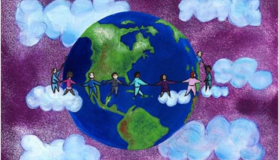(1) Oculesics (Textbook p.186)
It is the study of communications sent by the eyes. Eye contact is a nonverbal technique that helps the speaker"sell" his or her ideas to an audience. It varies not only culturally but also according to personality and gender. Eyes can reveal social poise, anxiety, submission, confidence, and credibility.
(2) Olfactics (Textbook p.187)
It is the study of communication via smell. For example, in Bali, when lovers greet one another, they often breathe deeply in a kind of friendly sniffing.
(3) Haptics (Textbook p.188)
Haptics refers to communicating through the use of bodily contact.
(4) Kinesics (Textbook p.189-192)
It refers to gestures, facial expression,s body position, body movement, and forms of greeting and theri relaitons to communication.
Gesture: a form of non-verbal communication made with a part of the body,used instead of or in combination with verbal communication, i.e., gestures performed by one or two hands.
Posture: the way someone stands, sits, or walks, and it can send positive or negative nonverbal messages; it can also signal agreement of disagreement with the other. It offers insights into a culture's deep structure.
Facial expression: one or more motions or positions of themuscles in the skin. These movements convey the emotional state of the individual to observers.
(5) Chromatics (Textbook p.192)
Chromatics is the study of color.
(6) Attire (Textbook p.193)
Attire refers to clothing and physical appearance.


